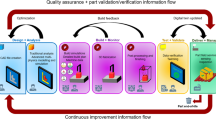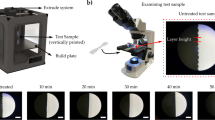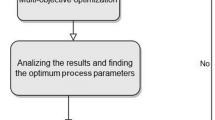Abstract
This study deals with a novel post-process for polymeric components obtained by FFF based on the combination of annealing at controlled temperatures and isostatic vacuum pressing. The experimental development based on the Response Surface Methodology (RSM) allowed us to define an optimal combination of process parameters. The experimental results confirm the enhancement for different printing orientations showing a significantly improved intralayer and interlayer adhesion and demonstrating the capability of the proposed method to reduce the anisotropy of the treated parts, which can be extrapolated to other FFF polymers.
You have full access to this open access chapter, Download conference paper PDF
Similar content being viewed by others
Keywords
1 Introduction
Fused Filament Fabrication (FFF) is an Additive Manufacturing (AM) technology that still presents certain limitations limiting its industry consolidation. Two examples are the mechanical performance, which is affected by the anisotropy derived from the technology and the poor surface quality, influenced by interlayer and interfilament bonding [1]. However, post-treatments can address these drawbacks [2, 3], such as thermal annealing [4,5,6] or other post-processes capable of decreasing the characteristic surface roughness and improving part performance [7, 8].
This research aims to provide experimental evidence on the benefits of thermal post-processing of FFF polymers, aimed at improving the bond strength between filaments, thus reducing the mechanical anisotropy through a densification process while introducing an improvement in the surface quality of the components.
In this work, the high-performance polyetherimide PEI Ultem 9085 is used. Ultem 9085 is an advanced polymer used in the aerospace and automotive industries due to its outstanding strength-to-weight ratio and FST (flame retardant, low smoke, and toxicity). This research provides a new high-temperature thermal annealing approach, carried out in a pressurised environment, to treat Ultem PEI parts obtained by AM.
2 Methodology
The present study is an iterative process to improve printed parts’ mechanical properties and anisotropy. First, specimens were fabricated in the XY and XZ direction and heat treated with and without vacuum, according to an initial experimental Doehlert matrix. Then, dimensional changes and mechanical properties were evaluated, and the pressurised environment was fixed for the second iteration until an optimum point was obtained. Finally, the results of both orientations are compared to evaluate the reduction of anisotropy and the improvement in mechanical performance.
ASTM D790 bending specimens (4 × 10 × 127 mm) were fabricated on a Fortus 400mc industrial printer using Ultem 9085. The printing parameters were a layer width of 0.254 mm, solid infill arranged at ±45° with a single contour, and a printing temperatures chamber of 195 °C and material extrusion of 380 °C. Samples were printed in the XY and the XZ orientation (worst-case condition). Post-treatment was carried out in a thermal chamber TH2700. To study the combined effect of heat treatment with vacuum pressure, some specimens were introduced into a polyamide vacuum bag with a valve connected to a 0.1 MPa vacuum device. The thermal process was done in three stages: initial heating (at a constant rate of 5 °C-min−1), maintenance at the target temperature (according to DoE times) and cooling (gradual in the chamber itself). The mechanical testing was done on a Zwick Roell Z030 universal testing machine with a three-point bending test setup according to ASTM D790.
The Response Surface Methodology (RSM) was chosen to determine the significance of the results. Specifically, the Doehlert Design (DD) matrix was used to minimise the number of experiments, detect the lack of fit of the model and create sequential designs. For the factors (pressure and temperature) optimisation, the coded matrix (see Table 1) was used, obtaining seven equispaced experiences in the experimental domain in the form of a regular hexagon with a central point (Fig. 1). The process temperature was chosen as variable x1 (175 to 201 °C), and the time the specimen was kept at that temperature as x2 (0.5 to 3.4 h). The second DD variables were x1 (191 to 205 °C) and x2 (3 to 6 h). The experimental matrix was obtained by converting the values of the coded variables into uncoded values using Eq. 1:
The presence of a pressurized environment was considered a categorical factor (not contemplated in the Doehlert matrices), so the matrix experiments were performed in duplicate: under atmospheric pressure and in a pressurized environment. Three response factors related to the flexural mechanical behaviour were selected to investigate the adequacy of the process and carry out the optimization: Eflex, σmax and ε(σmax). The statistical analysis of the results was carried out with Minitab software.
3 Results and Discussion
Table 2 shows the average results obtained in the three-point bending tests after heat treatment of the ZX specimens, according to the first Doehlert design. Apparent differences were observed between the flexural modulus of the specimens treated in a pressurised environment (ID 1–7) to those treated under atmospheric pressure (ID 1*–7*). It should also be noted that the specimens with improved strength (3–5, 7, 4* and 5*) are also more ductile, i.e., indicating a decrease in possible printing defects. Statistical analysis established that the optimum process conditions were 201 °C and 3.2 h under a pressurised environment. These values are at one extreme of the experimental domain, indicating that moving it towards the optimum point is necessary while keeping a pressurised environment in the new iteration.
Figure 2 shows the results of dimensional changes caused by heat treatment of ZX and XY specimens in percentage variation. The diagram of the specimens qualitatively indicates the increase or decrease in dimension according to the direction of the arrows. The differences between the XY specimens treated at atmospheric pressure are generally more significant than those of the ZX specimens. This conclusion agrees with that postulated by Zhang et al. [9]. By allowing thermal relaxation, residual stresses on faces perpendicular to the printing direction are relieved, thus increasing the dimension. Post-treatments performed in a pressurized environment show not only that the dimensional changes are minor but also that there is a compaction of the specimen as the decrease in the height dimension is not compensated by an increase in the rest of the dimensions.
The second experimental domain is shown in Fig. 1 (right). Table 3 collects the mean values of the bending test results, showing an apparent increase in all mechanical properties compared to the results of the first experimental matrix. However, differences between the values are minor, indicating a stabilization in the improvements produced by post-processing. Particularly relevant is the increase in the strain at maximum stress, attributed to increased cohesion between the layers.
Statistical processing of the results established that a vacuum pressure post-treatment at 201 °C for 4.4 h could provide optimum mechanical properties. This point’s mechanical property prediction intervals were calculated, and the corresponding confirmatory experiments were carried out. The values of Eflex, σmax and ε(σmax) obtained with a 95% prediction interval were 2359 ± 204 MPa, 117 ± 9 MPa, and 7.2 ± 1%, respectively. Looking at those intervals, it can be seen that, except for experimental points 3, 8, and 9, all other points of the second iteration have resulted in optimal. Thus, rather than a single optimum point, an optimum zone comprised of heat and vacuum pressure treatments ranging from 198 °C for 3.2 h to 204 °C for 5.8 h has been reached.
Finally, Table 4 collects the results of ZX and XY specimens treated under the optimum conditions. The improvements for the XY specimens are less pronounced, as expected. The most notable improvements are found at bending stress (75% increase in ZX specimens) and maximum strain (83% increase in ZX specimens). Figure 3 (left) depicts the differences between the stress-strain curves of both cases. Comparing ZX and XY orientations, the differences are reduced to 1% and 23%, respectively, indicating the suitability of the treatment. The 3D profile in Fig. 3 (right) also shows a much flatter surface after treatment. This is due to the combined effect of temperature and vacuum pressure, which shifts the softened material from the peaks to the valleys (filament bonding). On average, ZX samples have decreased their Ra and Rz by 90%, while XY samples have decreased their Ra and Rz by 50%. The dimensional changes suffered by the specimens treated with the optimum conditions were not more significant than a 4% decrease in height, the changes in the other two dimensions being negligible.
4 Conclusions
This research demonstrates the feasibility of post-processing Ultem 9085 parts fabricated by FFF to improve their mechanical performance and the quality of inter-layer and intralayer bonds. The main conclusions can be summarized as follows:
-
Dimensions of faces perpendicular to the fabrication direction tend to increase when heat is treated under atmos. Pressure. When using isostatic pressure, these changes are minimized, and specimens are compacted, i.e., densified.
-
The response surface methodology has proven to be suitable for evaluating the change in properties of the treated specimens and finding an optimum zone.
-
Experimental results confirm that the optimum point (201 °C for 4.4 h with pressure) is within the prediction range of the statistical method.
-
The treatment has strengthened the intra- and interlayer bonds.
-
The specimens fabricated in both directions using the optimal process parameters show a significant reduction of mechanical anisotropy, which is one of the main challenges for the industrial consolidation of this technology.
References
Morales, N.G., et al.: The effect of interlayer cooling on the mechanical properties of components printed via fused deposition. Addit. Manuf. 24, 243–248 (2018)
Chohan, J.S., Singh, R.: Pre and post processing techniques to improve surface characteristics of FDM parts: a state of art review and future applications (2017)
Shelton, T.E., et al.: Effects of thermal process parameters on mechanical interlayer strength for additively manufactured Ultem 9085. Polym. Test. 81, 106255 (2020)
Sreejith, P., et al.: A thermodynamic framework for AM using amorphous polymers capable of predicting residual stress, warpage and shrinkage. Int. J. Eng. Sci. 159, 103412 (2021)
Wach, R.A., et al.: Enhancement of mechanical properties of FDM-PLA parts via thermal annealing. Macromol. Mater. Eng. 303, 1800169 (2018)
Padovano, E., et al.: Mechanical and thermal behavior of ultem 9085 fabricated by fused-deposition modeling. Appl. Sci. 10, 3170 (2020)
Chueca de Bruijn, A., et al.: Optimization of a thermal annealing and isostatic pressing process for mechanical and surface enhancement. J. Manuf. Process. 85, 1096–1115 (2023)
Chueca de Bruijn, A., et al.: A comparative analysis of chemical, thermal, and mechanical post-process of FFF PEI parts for surface quality enhancement. Mater. 2021, 14 (2021)
Zhang, Y., Moon, S.K.: The effect of annealing on additive manufactured ULTEM 9085 mechanical properties. Materials 14, 2907 (2021)
Author information
Authors and Affiliations
Corresponding author
Editor information
Editors and Affiliations
Rights and permissions
Open Access This chapter is licensed under the terms of the Creative Commons Attribution 4.0 International License (http://creativecommons.org/licenses/by/4.0/), which permits use, sharing, adaptation, distribution and reproduction in any medium or format, as long as you give appropriate credit to the original author(s) and the source, provide a link to the Creative Commons license and indicate if changes were made.
The images or other third party material in this chapter are included in the chapter's Creative Commons license, unless indicated otherwise in a credit line to the material. If material is not included in the chapter's Creative Commons license and your intended use is not permitted by statutory regulation or exceeds the permitted use, you will need to obtain permission directly from the copyright holder.
Copyright information
© 2023 The Author(s)
About this paper
Cite this paper
Gómez-Gras, G., de Bruijn, A.C., Abad, M.D., Forés-Garriga, A., Pérez, M.A. (2023). Effects of Temperature and Vacuum Pressure on the Mechanical and Surface Enhancement of FFF Parts. In: Vizán Idoipe, A., García Prada, J.C. (eds) Proceedings of the XV Ibero-American Congress of Mechanical Engineering. IACME 2022. Springer, Cham. https://doi.org/10.1007/978-3-031-38563-6_50
Download citation
DOI: https://doi.org/10.1007/978-3-031-38563-6_50
Published:
Publisher Name: Springer, Cham
Print ISBN: 978-3-031-38562-9
Online ISBN: 978-3-031-38563-6
eBook Packages: EngineeringEngineering (R0)







